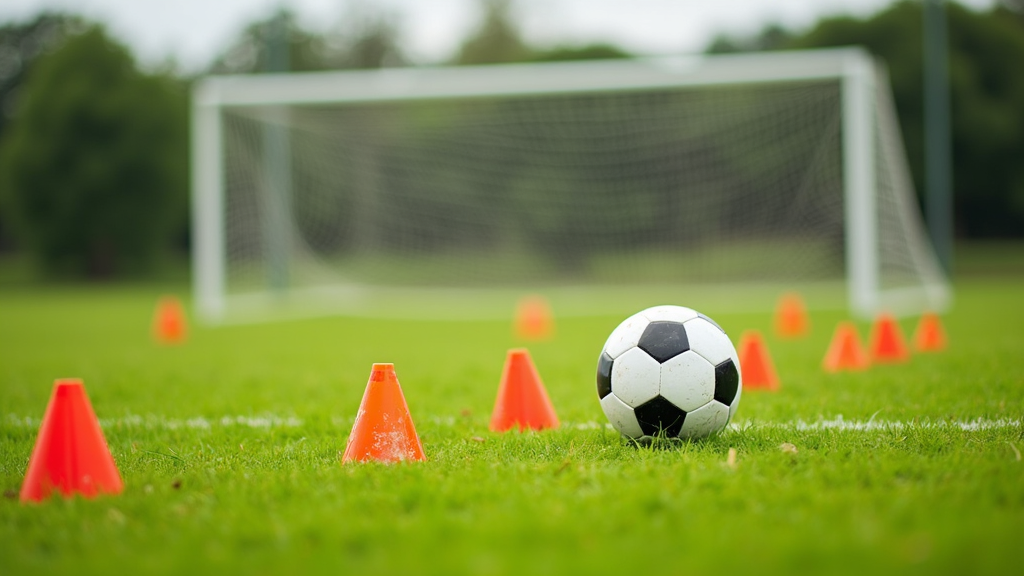 Training for soccer on your own can actually be a pretty rewarding experience. Not every player has access to a coach, but you can still improve your skills, fitness, and soccer IQ with a bit of structure and dedication. I’ve spent a good chunk of my own soccer adventure practicing solo, and I’ve picked up some tips along the way for making solo training count. Whether you play for your school, a local club, or just want to get better in the backyard, you’ll find a practical roadmap here for growing your game without a coach whispering instructions in your ear.https://www.wealthyaffiliate.com?a_aid=a12e49d9
Training for soccer on your own can actually be a pretty rewarding experience. Not every player has access to a coach, but you can still improve your skills, fitness, and soccer IQ with a bit of structure and dedication. I’ve spent a good chunk of my own soccer adventure practicing solo, and I’ve picked up some tips along the way for making solo training count. Whether you play for your school, a local club, or just want to get better in the backyard, you’ll find a practical roadmap here for growing your game without a coach whispering instructions in your ear.https://www.wealthyaffiliate.com?a_aid=a12e49d9
So if you’re tired of waiting for team practices or just want to get some extra work in, here’s an all-in-one guide to training for soccer all by yourself. These steps cover everything from building your personal practice routine to boosting your soccer smarts and confidence each week. Let’s jump right into it.
Step 1: Set Clear Soccer Goals
Solo training works best when you know what you’re aiming for. Clarity makes your sessions focused and helps you track progress. Everyone’s adventure looks different; you might want to improve dribbling, work on your fitness, or just feel more confident with the ball. Take some time to figure out what matters most to you. Are you trying to get ready for tryouts, step up your place on the team, or just track down new skills?
Questions to Guide Your Goals:
- What position do I mainly play? (Defender, midfielder, forward, goalkeeper?)
- Which soccer skills do I struggle with the most?
- What do I want to improve this season? (Speed, shooting, endurance, etc.)
- How much time can I realistically commit each week?
Example Soccer Goals:
- Work on ball control using both feet.
- Increase sprint speed over 20 meters.
- Get 100 successful juggles in a row.
- Practice crossing accuracy from the wing.
Being specific with your goals makes it easier to create sessions that actually help you grow as a player. Another tip is to write your goals somewhere visible, so you keep your focus sharp all week.
Step 2: Build a Balanced Training Schedule
Consistency over time is what helps you improve, even if you’re training by yourself. I’ve found that a simple routine takes all the guesswork out of each day’s session and helps to notice where you’re making progress.
How to Break Down Your Training Week:
- Technical sessions (ball control, dribbling, passing)
- Physical training (speed, cardio, strength, agility drills)
- Tactical study (watching games, learning positioning, strategy)
- Recovery (stretching, foam rolling, light movement days)
If you can fit in three or four sessions a week—even just 30-45 minutes each—you’ll start to see results. Putting rest and easy days between tough sessions helps you stay fresh. The beauty of solo practice is you can make it fit your life—even early morning, lunchtime, or in the evening. Try mapping out your week so you know what you’re doing before you get to the field.
Remember, the goal is progress, not perfection. If you miss a day, no worries; just keep moving forward the next session.
Step 3: Master Ball Skills Through Solo Drills
The more comfortable you get with a soccer ball at your feet, the better you’ll handle pressure in a real match. Good solo drills focus on touches, control, and quick thinking. Don’t be afraid to repeat the basics—these are the building blocks for next-level cool moves later.
Simple Solo Ball Drills:
- Wall passes: Kick against a wall using one or both feet; focus on accuracy and control as the ball returns to you. Set a target (like 50 passes without losing the ball).
- Juggling: Start with keeping the ball up with feet, thighs, and head. Try beating your best score each time. It’s a fun way to improve touch and focus.
- Dribble cones: Set up 5-10 cones or small items and weave through them, keeping the ball close and under control. Go for speed without losing your touch.
- Turns and moves: Practice simple moves like the Cruyff turn, stepovers, or dragbacks in a small area. Alternate feet to keep your skills balanced and sharp on both sides.
- Shooting accuracy: Use a wall as a target, or mark out corners of a small goal with cones. Track how many shots out of 10 hit the target area. Challenge yourself to improve each session.
Switch up your routine by changing speed, using your weaker foot, or timing certain drills. Adding variety keeps things fresh and makes you more balanced as a player.
Step 4: Boost Soccer Fitness on Your Own
Fitness is massive in soccer. Since games include lots of sprinting, changing direction, and short rest periods, your training should match that. I keep my sessions fun by mixing things up often; sometimes I run, other days it’s sprints and plyo jumps.
Key Fitness Areas to Hit:
- Endurance: Go for steady-paced runs or try interval jogging—switching between hard sprints and light jogging. This gets your body used to the demands of a real match.
- Agility: Use cones or even bottles for ladder drills, zigzags, or quick side-to-side movements. Good agility means fast feet and better balance.
- Explosive power: Try squat jumps, bounding, and short sprints (10-20 meters). These exercises make you more explosive off the mark and give a boost to your first step.
- Strength: Bodyweight moves like pushups, situps, planks, and lunges are great for building core and leg strength, even if you don’t have equipment.
Tracking your improvement—such as shaving seconds off sprint times, or doing more reps than last week—gives you clear proof of your growth. Don’t forget to stretch before and after for injury prevention. If you’re new, ease into fitness sessions to tone down any risk of overdoing it.
Step 5: Study Soccer Tactics and Game Sense
Understanding what to do off the ball is just as important as having eye-catching footwork. Spend some time watching pro matches or highlights, making notes about good movement, team shape, or how different players handle pressure. Even ten minutes a day can add up over time.
Practical Ways to Build Soccer IQ:
- Watch pro games and try to focus on your main position. How does that player move, make space, or react to defenders?
- Take notes on team shape and how players support each other during attack and defense.
- Look for patterns, like overlapping runs, how teams build out from the back, or what they do when they lose the ball.
- Replay your own games or practice if you can record them. You’ll spot things you missed in real time, which helps connect practice to real matches.
Jumping into strategies and pattern recognition makes solo training feel more purposeful and helps you play smarter. Learn from the best by studying their decisions—not just their skills.
Step 6: Track Your Progress and Adjust
Solo training pays off best when you track what you’re doing and switch things up as you go. I like writing a quick summary after each session in a notebook or on my phone. It doesn’t have to be complicated. Jot down what you worked on, areas that felt tough, or new moves you want to conquer next time.
Ideas for Tracking:
- Write your best juggling score, dribbling times, or sprint distances.
- Make notes on what felt awkward or tough—next time, focus on those things with a new trick or different routine.
- Set a small target for the week (like doing wall passes three times), then check it off when done.
Looking back over a couple of months really shows how far you’ve come. It builds your confidence and helps you spot patterns in what works best for you.
Step 7: Stay Motivated and Connected
Training alone can get tough if you lose motivation. Connecting with friends online, mixing in new drills, and sometimes just changing your practice location helps keep things exciting.
Ways to Stay Inspired:
- Get involved with friends, join online soccer communities, or jump into community challenges (like keepie uppie contests or creative dribble routines).
- Switch up your routine every few weeks—try new drills, challenge yourself with your weaker foot, or check out fun soccer workout videos.
- When possible, schedule a regular pick-up game, or invite someone to join you for training occasionally for a quick 1v1 or passing session.
Remember: Small, steady improvements build up over time. Stay patient and enjoy the ride of becoming a more skilled, confident player.
Common Questions & Troubleshooting
What if I don’t have much space to train?
Even a small backyard or driveway works fine. Focus on close ball control, wall passes, and tight dribbling drills. Keep a mini-goal or target if you can; even a chalk mark on a wall works great.
How can I tell if I’m actually improving?
- Keep track of stats—juggle counts, wall pass numbers, dribble times, or the number of successful shots. Watching your numbers move up tells the full story.
- Take short videos occasionally for before-and-after comparisons. It can be eye-opening to notice little improvements you don’t feel in the moment.
How do I avoid getting bored?
Mix up new drills, practice with upbeat music, or set self-challenges (like using your weaker foot only for a week). Friendly competition—even against yourself—keeps things exciting and keeps pushing your limits.
Ready to Start Your Solo Soccer Training?
With a smart plan, determination, and a willingness to learn from every session, you can level up your soccer skills without a coach. Training solo builds independence and confidence, too, so you’ll be better prepared for both games and life—trust me!
Quick Action Plan:
- Set a clear soccer goal for this week—pick something specific that excites you.
- Pick 2-3 solo drills and schedule your practice days.
- Write down what you worked on each time—track progress and challenge yourself to keep growing!
What are you working on in your solo soccer sessions? Share your favorite tip, recent breakthrough, or a challenge you’re facing in the comments below. The solo grind pays off—just stick with it!
